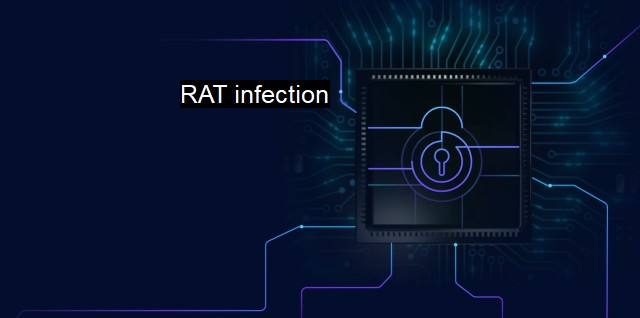What is RAT infection?
The Invisible Threat: Understanding the Devastating Impact of Remote Access Trojans (RATs) on Cybersecurity
In the vast expanse of the digital world, one swiftly growing concern is cybersecurity. Accelerated by the expanding reliance on technology and the internet, newer threats are continuously emerging. One such menace that has taken cyberspace by storm is the RAT (Remote Access Trojan) infection. It is a type of malware that allows hackers to control a system remotely without the user's knowledge or consent, turning the infected device into a ‘zombie’ or, in other words, a bot.RATs, as inferred from their name, provide criminal hackers with complete control over the victim's system following a successful intrusion. They are typically spread through popular modes of online communication, such as emails and instant messages, where users unsuspectingly click on malicious links or download corrupted files. Beyond these vectors, RATs can also exploit vulnerabilities within the system's security or software, thereby entering undetected.
Once the Remote Access Trojan infiltrates the device, user data is compromised. The nefarious control that hackers gain over the system allows them to rummage through, alter, or steal information. They also have the facility to view, create, change, or delete files, modify system configurations, install more malicious software, record keystrokes, and usurp control over attached systems like printers or cameras.
RAT infections can lead to serious financial loss due to various fraudulent activities, including online banking theft and cryptomining. Through the compromised system, hackers can send spam or carry out denial-of-service (DoS) attacks against other networks or systems, consequently utilizing the infected systems as proxy servers for illegal activities, thereby safeguarding their actual identities.
From a malicious actor's standpoint, the appeal of RAT infections lies in their discretion. Often disguised as bona fide software or embedded within them, imposition on a victim system tends to be surreptitious, going unnoticed until significant damage has been done. The ability of these malicious tools to provide pervasive access and control furthers their threat potential greatly.
To combat RAT infections, cybersecurity experts developed various protective measures. Key among these is the use of robust and reliable antivirus software capable of detecting and eradicating not just common viruses, but also discreet Trojan threats. Regular virus definition updates are crucial in identifying new variants of RAT malware.
In addition to this, firewalls constitute a vital defense, helping aptly block unauthorized assess while permitting secure connections for communication. Regular security patches and timely software updates also keep the system fortified against these evolving threats. Rectifying known exploits reduces susceptibility to RAT attacks, thereby shielding invaluable data from potential adversaries.
User education on the importance of safe browsing habits, the avoidance of suspicious websites, files, and links, especially ecommerce-related ones, as well as email attachments from unknown sources, are crucial elements for mitigating the risk. This stresses the greater aim of adopting a comprehensive cybersecurity culture, which, along with technical software defenses, provides an integrative approach to combat growing menaces like RATs.
a RAT infection is an extremely threatening cyberattack vector that leverages a user's lack of awareness and lax cybersecurity habits. With increasing digitalization, the avenues for such attacks are proliferating. Therefore, an education-rich environment coupled with stringent vigilance and robust defensive mechanisms is crucial in preventing these intrusions. For the digital age citizens, understanding cybersecurity is not just optional anymore; it's a necessary preventive measure protecting their digital footprint from being misused, thrown into disarray, or worse - becoming an accessory to cybercrime.

RAT infection FAQs
What is rat infection in cybersecurity?
Rat infection, also known as Remote Access Tool (RAT) infection, is a type of malware that allows hackers to gain remote access and control of a victim's computer.How does rat infection spread?
Rat infections can spread through various methods such as phishing emails, fake software updates, or malicious downloads. Hackers often hide the RAT in legitimate-looking files or software to trick victims into installing them.What are the signs of rat infection on a computer?
Some signs of rat infection on a computer include slow performance, unexplained changes in settings, pop-ups or ads appearing even when not browsing the internet, and suspicious network activity.How can I protect my computer from rat infection?
To protect your computer from rat infection, you should keep your antivirus software up-to-date, avoid clicking on suspicious links or downloading unverified software, and use caution when opening email attachments. It's also important to practice good cybersecurity habits such as using strong passwords and keeping your software and operating systems updated.| | A | | | B | | | C | | | D | | | E | | | F | | | G | | | H | | | I | | | J | | | K | | | L | | | M | |
| | N | | | O | | | P | | | Q | | | R | | | S | | | T | | | U | | | V | | | W | | | X | | | Y | | | Z | |
| | 1 | | | 2 | | | 3 | | | 4 | | | 7 | | | 8 | | |||||||